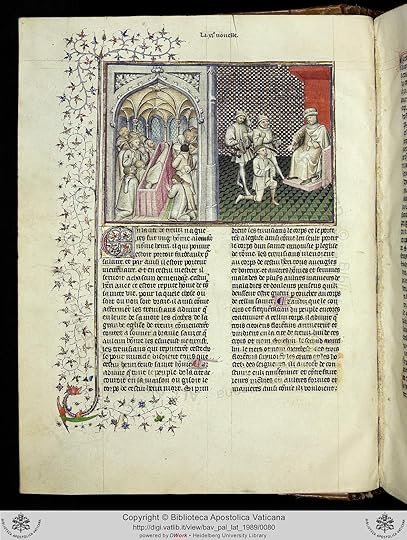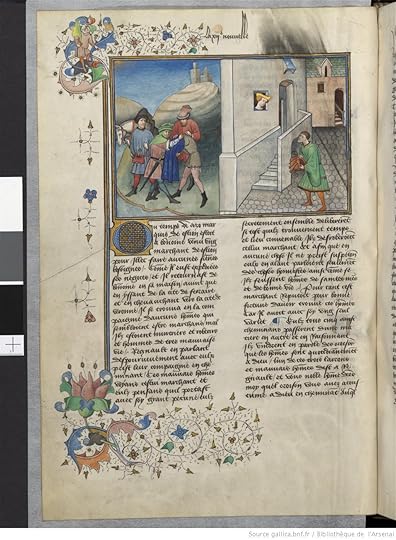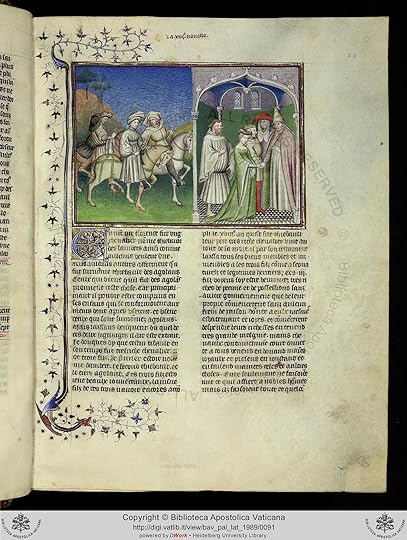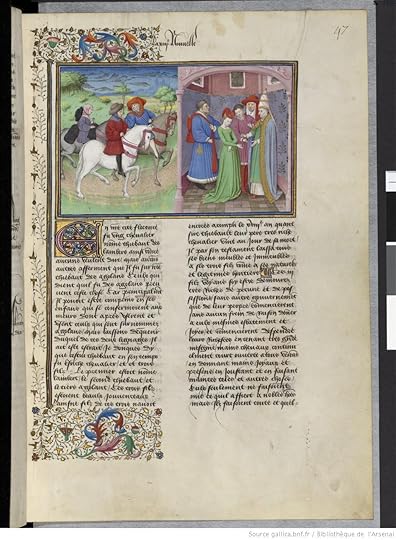Divine Comedy + Decameron discussion

This topic is about
The Decameron
Boccaccio's Decameron
>
6/16-6/22: Second Day, Introduction & Stories 1-5
date newest »
newest »
 newest »
newest »
message 1:
by
Kris
(new)
-
added it
Apr 14, 2014 09:45AM
 Mod
Mod
reply
|
flag
Wouldn't it be nicer for all of us to post on the same schedule? I usually save posts that are meant for further along in our read, and post them when we arrive at that date.
DL wrote: "Strangely enough, I didn't even realize I was ahead. I'm so used to lagging behind to the point of missing out altogether with my other group. I'll hold off on any further comments. For now at l..."
No worries DL! Isn't it a good feeling to be ahead and not running to catch up? Just send yourself an email with what you intend to post, and post it later. I have a few things saved as well.
No worries DL! Isn't it a good feeling to be ahead and not running to catch up? Just send yourself an email with what you intend to post, and post it later. I have a few things saved as well.
 Illustrations - Day II story 1
Illustrations - Day II story 1
http://visualiseur.bnf.fr/ConsulterEl...
Martellino au tombeau de saint Arrigo
(view spoiler)
 Illustrations - Day II Story 2
Illustrations - Day II Story 2
http://visualiseur.bnf.fr/ConsulterEl...
Jugement des agresseurs de Rinaldo d'Esti.
(view spoiler)
 Illustrations - Day II Story 3
Illustrations - Day II Story 3
http://visualiseur.bnf.fr/ConsulterEl...
Lamberto & ses frères en prison
(view spoiler)
 Illustrations - Day II Story 4
Illustrations - Day II Story 4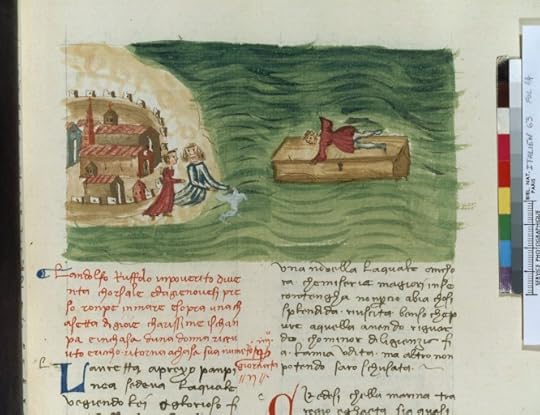
http://visualiseur.bnf.fr/ConsulterEl...
Landolfo Rufolo échappant au naufrage
(view spoiler)
 Illustrations - Day II Story 5
Illustrations - Day II Story 5
http://visualiseur.bnf.fr/ConsulterEl...
Andreuccio di Petri sortant du puits.
(view spoiler)
 Kalliope wrote: "Oh, good, with the Illuminations to illustrate me I can now proceed with the week's read."
Kalliope wrote: "Oh, good, with the Illuminations to illustrate me I can now proceed with the week's read."Exactly how I feel. Thank you, Oh Illuminator!!
 Thanks, Book Portrait, I was excited to see these illustrations, specially the one for the 5th story.
Thanks, Book Portrait, I was excited to see these illustrations, specially the one for the 5th story.(view spoiler)
In the second day, third story, there is mention of an Earl of Cornwall. I was curious as to what Boccaccio would know of England.
In Boccaccio's Decameron ii, 3, England is regarded as more exotic and fantastical than Barbary (the north African coast, just two hundred miles from Sicily): a place where a savvy young Tuscan might be seduced by an abbot (a princess in disguise), mortgage barons' castles and become Earl of Cornwall. The vernaculars of these distant islands were thus seen as eccentric and of scant literary consequence: the French chronicler Froissart, who spent the years 1361-7 in England, apparently never troubled to learn English, getting by in the European lingua franca (French). Over two centuries earlier, Chrétien de Troyes had written the great romances foundational to the values of chivalry celebrated by Froissart in his Chronicles; around 1275, the Roman de la Rose was approaching completion. Inspired in part by Italian receptions of the Rose, Dante composed not only the greatest European poem of all - his Commedia - but also a series of works to guide its future reception and interpretation. Petrarch, while championing Latin rather than Italian, nonetheless assembled a collection of Italian lyrics - the Canzoniere - that English poets would not fully fathom until the early sixteenth century. Boccaccio's greatest legacy to English literature, his framed collection of tales, was also not absorbed until the sixteenth century (when it eased the path to Shakespeare). Chaucer, however, made early and precocious use of Boccaccio and was ultimately inspired to fashion a framed collection of his own.
In Boccaccio's Decameron ii, 3, England is regarded as more exotic and fantastical than Barbary (the north African coast, just two hundred miles from Sicily): a place where a savvy young Tuscan might be seduced by an abbot (a princess in disguise), mortgage barons' castles and become Earl of Cornwall. The vernaculars of these distant islands were thus seen as eccentric and of scant literary consequence: the French chronicler Froissart, who spent the years 1361-7 in England, apparently never troubled to learn English, getting by in the European lingua franca (French). Over two centuries earlier, Chrétien de Troyes had written the great romances foundational to the values of chivalry celebrated by Froissart in his Chronicles; around 1275, the Roman de la Rose was approaching completion. Inspired in part by Italian receptions of the Rose, Dante composed not only the greatest European poem of all - his Commedia - but also a series of works to guide its future reception and interpretation. Petrarch, while championing Latin rather than Italian, nonetheless assembled a collection of Italian lyrics - the Canzoniere - that English poets would not fully fathom until the early sixteenth century. Boccaccio's greatest legacy to English literature, his framed collection of tales, was also not absorbed until the sixteenth century (when it eased the path to Shakespeare). Chaucer, however, made early and precocious use of Boccaccio and was ultimately inspired to fashion a framed collection of his own.
In 1241 Richard, Earl of Cornwall, King Henry III's younger brother, returned from a crusade in the Holy Land. He probably met or corresponded with Matthew Paris at St. Albans, and the tale he told allowed the illuminator to fill his pages with a number of curiosities. One of these curiosities Richard experienced in Italy where he was Emperor Friedrich II's guest. When Richard went to the city of Cremona he was met with a joyous procession led by a decorated elephant with a brass band playing on its back. This was the emperor's elephant, a part of his exotic menagerie for which he was well known, and a beast Matthew Paris had never seen. Consequently his depiction of the elephant relied heavily on a convention established in the bestiaries, for instance the beast's lack of knees.
Ignorance and Experience: An Illuminator's Trajectory
There is an animal called the elephant, which has no desire to mate.
- MS Bodley 764, translated by Richard Barber
Medieval bestiaries contained creatures both real and legendary, whose ways of life served as moral fables for humanity. These books were richly illustrated, but the illuminators rarely knew much about what the various beasts looked like, relying instead on traditional depictions or literary descriptions from authors like Pliny or Isidore of Seville. In some cases this should come as no surprise since many of the animals described did not exist or were at best distorted representations of actual animals. A favourite example of mine is the bonnacon, a beast with a bull's body and a horse's mane whose poisonous excrement was its only means of protection against predators.
http://my-albion.blogspot.com/2012/05...
There is an animal called the elephant, which has no desire to mate.
- MS Bodley 764, translated by Richard Barber
Medieval bestiaries contained creatures both real and legendary, whose ways of life served as moral fables for humanity. These books were richly illustrated, but the illuminators rarely knew much about what the various beasts looked like, relying instead on traditional depictions or literary descriptions from authors like Pliny or Isidore of Seville. In some cases this should come as no surprise since many of the animals described did not exist or were at best distorted representations of actual animals. A favourite example of mine is the bonnacon, a beast with a bull's body and a horse's mane whose poisonous excrement was its only means of protection against predators.
http://my-albion.blogspot.com/2012/05...
 I'm glad you all like the illustrations! :)
I'm glad you all like the illustrations! :)With a little help from Yann {merci Yann!} I found a new way of copying the images from Gallica (BnF) so I can zoom in on them. Here's the Arsenal 5070 manuscript zoomed in on the part of the page with the illustrations (for the full page, click on each picture... *super geeky geek*):
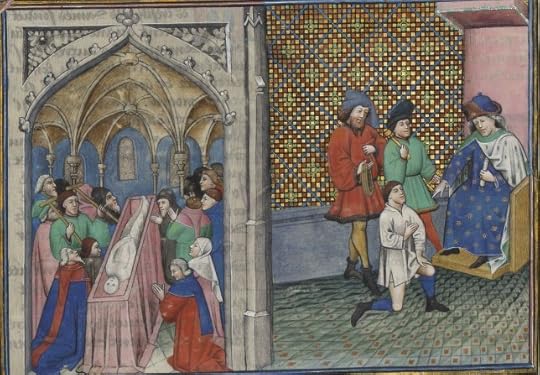
Day II Story 1

Day II Story 2
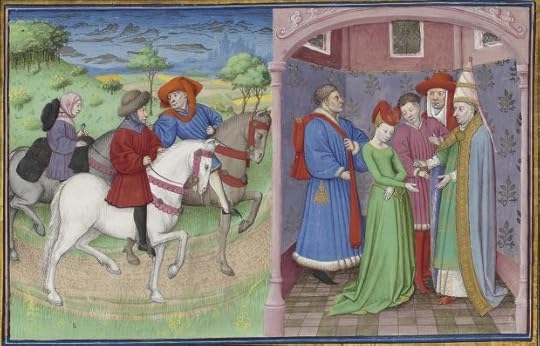
Day II Story 3

Day II Story 4

Day II Story 5
Book Portrait wrote: "I'm glad you all like the illustrations! :)
With a little help from Yann {merci Yann!} I found a new way of copying the images from Gallica (BnF) so I can zoom in on them. Here's the Arsenal 5070 ..."
These last ones, are gorgeous... they really try to depict as much as they can from the full tale, creating the narrative with the succession of "vignettes" -- and not just one scene.
With a little help from Yann {merci Yann!} I found a new way of copying the images from Gallica (BnF) so I can zoom in on them. Here's the Arsenal 5070 ..."
These last ones, are gorgeous... they really try to depict as much as they can from the full tale, creating the narrative with the succession of "vignettes" -- and not just one scene.
I am amused to see how in Tale 4, the Amalfi coast is already attracting tourism....
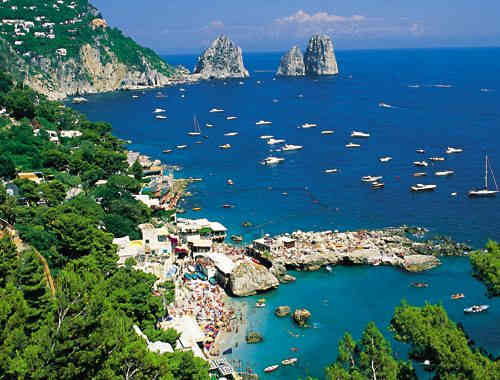
And a little map - very close to Naples.... which Boccaccio knew well.


And a little map - very close to Naples.... which Boccaccio knew well.

Toto wrote: "In this week's stories, we hear of how Fortune "controls all the affairs we unthinkingly call our own" and "arranges and rearranges them after her own inscrutable fashion." This seems to follow ex..."
Interesting observations... In Dante I got the impression that he put a greater onus on the human "free" will than on god's will,.. and then there is the inexplicable chance.
Interesting observations... In Dante I got the impression that he put a greater onus on the human "free" will than on god's will,.. and then there is the inexplicable chance.
 ReemK10 (Paper Pills) wrote: "In the second day, third story, there is mention of an Earl of Cornwall. I was curious as to what Boccaccio would know of England."
ReemK10 (Paper Pills) wrote: "In the second day, third story, there is mention of an Earl of Cornwall. I was curious as to what Boccaccio would know of England."Yes it is interesting, particularly thinking of other stories with foreign settings in Decameron. The treatment of England (and Scotland) in the 2/3 story and the behaviour of the royal family is entirely fantastical. No civil war between father and son in this period either, you'd have to go back to the 12th century for that. But Boccaccio doesn't have a problem treating England as a fantasy location.
In this period learning English wouldn't have been necessary to conduct business in England unless one wanted to talk to servants or peasants. French was still the language of court and high society but would start to share that position with English at the end of the 14th century.
 Kalliope wrote: "I am amused to see how in Tale 4, the Amalfi coast is already attracting tourism..."
Kalliope wrote: "I am amused to see how in Tale 4, the Amalfi coast is already attracting tourism..."Amalfi was one of the earliest trading cities in Italy, specialising in long distance overseas business before the rise of Genoa and Pisa.
The story is a throwback to that I suspect, interesting because the trader has no problem becoming a pirate to make money when that looks more profitable. In later ages one might start a bank instead!
Jan-Maat wrote: "Kalliope wrote: "I am amused to see how in Tale 4, the Amalfi coast is already attracting tourism..."
Amalfi was one of the earliest trading cities in Italy, specialising in long distance overseas..."
I found this list of pirates. I wonder which pirate actually inspired Boccaccio:
Famous Medieval Pirates
http://www.ranker.com/list/famous-med...
Amalfi was one of the earliest trading cities in Italy, specialising in long distance overseas..."
I found this list of pirates. I wonder which pirate actually inspired Boccaccio:
Famous Medieval Pirates
http://www.ranker.com/list/famous-med...
Jan-Maat wrote: "Kalliope wrote: "I am amused to see how in Tale 4, the Amalfi coast is already attracting tourism..."
Amalfi was one of the earliest trading cities in Italy, specialising in long distance overseas..."
The town of Amalfi looks quite special...
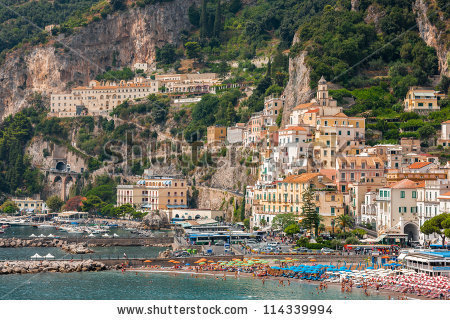
But in the tale, Boccaccio is discussing the full coast..., and the town of Ravello... another beautiful one..
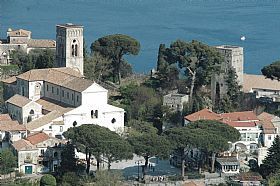
Amalfi was one of the earliest trading cities in Italy, specialising in long distance overseas..."
The town of Amalfi looks quite special...

But in the tale, Boccaccio is discussing the full coast..., and the town of Ravello... another beautiful one..

I was discussing with a friend(Ce Ce of Goodreads) how the Virgin Mary's father was named Joachim which translates to Imran in Arabic, and how there is a chapter in the Quran that is about the family of Imran, when she told me about traveling to Ephesus in Turkey and seeing the house of the Virgin Mary. Of course I had to google this and thought I would see if there might also be a connection to the Decameron as well.
Boccaccio borrowed the plots of almost all of his stories. Although he had access to just French, Italian, and Latin sources, some of the tales have their ultimate origin in such far-off lands as India, Persia, Spain, and other places. Moreover, some were already centuries old.
For example, part of the tale of Andreuccio of Perugia (Day II, Story 5) originated in second century Ephesus (in the Ephesian Tale).
Check out Ephesus:
http://www.sacred-destinations.com/tu...
Boccaccio borrowed the plots of almost all of his stories. Although he had access to just French, Italian, and Latin sources, some of the tales have their ultimate origin in such far-off lands as India, Persia, Spain, and other places. Moreover, some were already centuries old.
For example, part of the tale of Andreuccio of Perugia (Day II, Story 5) originated in second century Ephesus (in the Ephesian Tale).
Check out Ephesus:
http://www.sacred-destinations.com/tu...
Fifth tale (II, 5)
Andreuccio da Perugia comes to Naples to buy horses, meets with three serious adventures in one night, comes safe out of them all, and returns home with a ruby.
Fiammetta tells this story which is actually a combination of two earlier tales. The beginning of the tale is first recorded in about 1228 by Courtois d'Arrass in his "Boivin de Provins." The portion of Andreuccio being trapped in the tomb of the archbishop and how he escapes comes from the Ephesian Tale by Xenophon of Ephesus, which was written in about 150 AD. That portion of the tale is so memorable that it was still being told as a true story in the cities and countryside of Europe in the early 20th century.
The Ephesian Tale: http://en.wikipedia.org/wiki/Ephesian...
Andreuccio da Perugia comes to Naples to buy horses, meets with three serious adventures in one night, comes safe out of them all, and returns home with a ruby.
Fiammetta tells this story which is actually a combination of two earlier tales. The beginning of the tale is first recorded in about 1228 by Courtois d'Arrass in his "Boivin de Provins." The portion of Andreuccio being trapped in the tomb of the archbishop and how he escapes comes from the Ephesian Tale by Xenophon of Ephesus, which was written in about 150 AD. That portion of the tale is so memorable that it was still being told as a true story in the cities and countryside of Europe in the early 20th century.
The Ephesian Tale: http://en.wikipedia.org/wiki/Ephesian...
 Book Portrait wrote: "Illustrations - Day II Story 5
Book Portrait wrote: "Illustrations - Day II Story 5http://visualiseur.bnf.fr/ConsulterEl...
Andreuccio di Petri sortant du puits.
THanks again for sharing these!
http://digi.vatlib.it/diglitData/image/b..."
 Book Portrait wrote: "I'm glad you all like the illustrations! :)
Book Portrait wrote: "I'm glad you all like the illustrations! :)With a little help from Yann {merci Yann!} I found a new way of copying the images from Gallica (BnF) so I can zoom in on them. Here's the Arsenal 5070 ..."
These remind me of ex votos, in that they tell as much of the story as possible in few frames.



